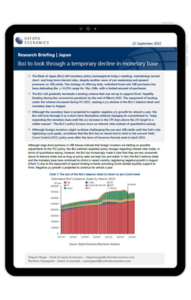BoJ to look through a temporary decline in monetary base
 The Bank of Japan (BoJ) left monetary policy unchanged at today’s (22nd Sep) meeting, maintaining current short- and long-term interest rates, despite another wave of yen weakening and upward pressures on JGB yields. The strategy of offering daily, unlimited fixed-rate JGB purchases has been defending the +/-0.25% range for 10yr JGBs, with a limited amount of purchases.
The Bank of Japan (BoJ) left monetary policy unchanged at today’s (22nd Sep) meeting, maintaining current short- and long-term interest rates, despite another wave of yen weakening and upward pressures on JGB yields. The strategy of offering daily, unlimited fixed-rate JGB purchases has been defending the +/-0.25% range for 10yr JGBs, with a limited amount of purchases.
What you will learn:
- The BoJ will gradually terminate a lending scheme that was set up to support firms’ liquidity funding during the coronavirus pandemic by the end of March 2023. The repayment of lending under the scheme increased during H1 2022, causing a y/y decline in the BoJ’s balance sheet and monetary base in August.
- Although the monetary base is projected to register negative y/y growth for almost a year, the BoJ will look through it as a short-term fluctuation without changing its commitment to “keep expanding the monetary base until the y/y increase in the CPI stays above the 2% target in a stable manner”. The BoJ’s policy focuses more on interest rates instead of quantitative easing.
- Although foreign investors might continue challenging the yen and JGB yields until the Fed’s rate tightening cycle peaks, we believe that the BoJ has no choice but to stick to the current Yield Curve Control (YCC) policy even after the term of Governor Kuroda ends in April 2023.
Tags:
Related posts

Post
How Asia’s supply chains are changing | Techonomics Talks
Global supply chains have continued to expand, despite talk of deglobalization and nearshoring. US and Japan have started to de-couple from China, but other G7 countries grow more dependent on Chinese inputs. Several "hotspots" are emerging across Asia with multiple winning formulas.
Find Out More
Post
BoJ to raise its policy rate cautiously to 1% by 2028
We now project that the Bank of Japan will start to raise its policy rate next spring assuming another robust wage settlement at the Spring Negotiation. If inflation remains on a path towards 2%, the BoJ will likely raise rates cautiously to a terminal rate of around 1% in 2028.
Find Out More
Post
Japan inflation to rise to 1.8%, but downside risks are high
Reflecting a surprisingly strong Spring Negotiation result and weaker yen assumption, we have upgraded our baseline wage and inflation forecasts. We now project higher wage settlements will push inflation towards 1.8% by 2027. Uncertainty is high, however.
Find Out More